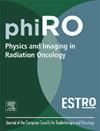Multi-institution longitudinal apparent diffusion coefficient measurements in a diffusion weighted imaging phantom at room temperature
IF 3.3
Q2 ONCOLOGY
引用次数: 0
Abstract
Background and purpose
This work contributes to technical validation of apparent diffusion coefficient (ADC) as a biomarker of cancer. The aim was to evaluate ADC accuracy, random error, short-term and long-term repeatability and reproducibility, across multiple institutions using a room temperature phantom.
Materials and methods
ADC measurements were made in a travelling room temperature diffusion weighted imaging (DWI) phantom on six scanners at four UK institutions over 18 months at six-month intervals. ADC bias measurements were calculated as the difference between measured and temperature corrected ground-truth ADC values and used to calculate mean ADC bias, isocentre ADC error estimate, short- and long-term intra-scanner repeatability as per the Quantitative Imaging Biomarkers Alliance (QIBA) DWI profiles, and inter-scanner reproducibility by calculating the 95 % limits of agreement for all ADC bias measurements.
Results
The use of a room-temperature phantom with a magnetic resonance (MR) readable thermometer enabled ADC measurements without ice-water setup, considerably simplifying logistics with respect to multi-institution ADC quality assurance. Mean ADC bias across all scanners and sessions was <0.01 × 10−3 mm2 s−1 (0.81 %); mean isocentre ADC error estimate was 1.43 %; average scanner short-term repeatability was <0.01 × 10−3 mm2 s−1 (1 %). Reproducibility was 0.07 × 10−3 mm2 s−1 (9 %).
Conclusion
Results indicated good ADC accuracy, repeatability and reproducibility; demonstrating the feasibility of transferring diagnostic DWI sequences between scanners from the same manufacturer, for use in multi-institution longitudinal studies, and assessing ADC with minimal quality control and harmonisation steps required.
室温下扩散加权成像模体中多机构纵向表观扩散系数的测量
背景与目的本研究有助于表观扩散系数(ADC)作为癌症生物标志物的技术验证。目的是评估ADC的准确性,随机误差,短期和长期的可重复性和再现性,在多个机构使用室温模体。材料和方法sadc测量是在英国四家机构的六台扫描仪上进行的,在18个月的时间里,每隔六个月进行一次扩散加权成像(DWI)。ADC偏置测量值计算为测量值与温度校正后的真值ADC值之间的差值,并用于计算平均ADC偏置、等中心ADC误差估计、根据定量成像生物标志物联盟(QIBA) DWI配置文件的扫描仪内短期和长期可重复性,以及通过计算所有ADC偏置测量值的95%一致性限制来计算扫描仪间可重复性。结果使用带有磁共振(MR)可读温度计的室温模体,无需冰水设置即可实现ADC测量,大大简化了多机构ADC质量保证的后勤工作。所有扫描仪和会话的平均ADC偏置为<;0.01 × 10−3 mm2 s−1 (0.81%);平均等心ADC误差估计为1.43%;平均扫描仪短期重复性为<;0.01 × 10−3 mm2 s−1(1%)。重现性为0.07 × 10−3 mm2 s−1(9%)。结论具有良好的ADC准确度、重复性和再现性;演示了在同一制造商的扫描仪之间转移诊断性DWI序列的可行性,用于多机构纵向研究,并以最少的质量控制和协调步骤评估ADC。
本文章由计算机程序翻译,如有差异,请以英文原文为准。
求助全文
约1分钟内获得全文
求助全文
来源期刊

Physics and Imaging in Radiation Oncology
Physics and Astronomy-Radiation
CiteScore
5.30
自引率
18.90%
发文量
93
审稿时长
6 weeks
 求助内容:
求助内容: 应助结果提醒方式:
应助结果提醒方式:


